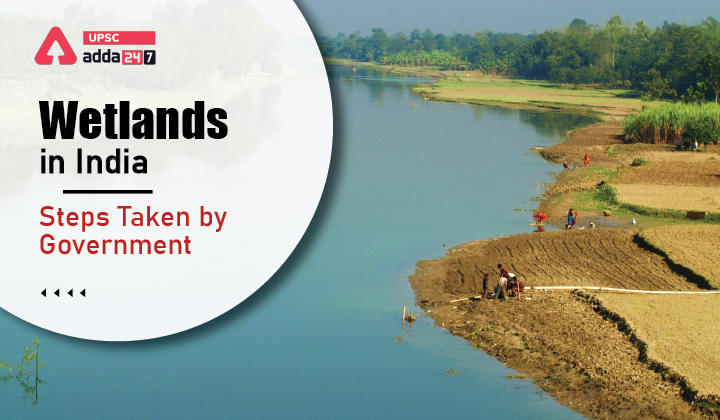Table of Contents
Wetlands in India- Relevance for UPSC Exam
- GS Paper 3: Environment- Conservation, environmental pollution and degradation.
Wetlands in India in News
- Recently, total 15 Indian Wetland Sites were designated as the Ramsar Sites of International Importance under Ramsar Convention.
- So far, 64 wetlands covering an area of 12,50,361 ha have been designated as Ramsar Sites of International Importance from India.
- Out of 64 Ramsar sites, 38 were designated in the last 7 years, i.e., from 2014 to till date.
List of Ramsar Wetland Sites in India
What is a Wetland in India?
- According to the Wetlands (Conservation and Management) Rules 2017, an area of marsh, fen, peat land or water; whether natural or artificial, permanent or temporary, with water that is static or flowing, fresh, brackish or salt, including areas of marine water the depth of which at low tide does not exceed six meters, are considered as wetlands.
Wetlands in India- Area under Wetlands
- As per the National Wetland Inventory & Assessment, 2011, Space Applications Centre- ISRO Ahmedabad identified approximately 2.0 lakhs water bodies/wetlands (>2.25 hectares) across the country covering an area of approximately 10 million ha.
- These includes lakes/ponds, ox-bow lakes, high altitude & riverine wetlands, waterlogged areas, tanks, reservoirs, lagoons, creeks, sand beaches, corals, mangroves, mud flats, salt pans, aquaculture ponds, salt marshes, etc.
Regulatory Framework for Wetland Conservation in India
- Environment Ministry has notified Wetlands (Conservation and Management) Rules, 2017 under the provisions of the Environment (Protection) Act, 1986 as regulatory framework for conservation and management of wetlands across country.
- It aims to conserve, manage and maintain the ecological character of the wetlands without restricting its wise use.
National Plan for Conservation of Aquatic Eco-systems (NPCA)
- About: NPCA is being implemented for conservation and management of identified wetlands (includes lakes) in the country on cost sharing basis between Central Government and respective State Governments.
- Implementing Ministry: Ministry of Environment, Forest & Climate Change (MoEF&CC) is implementing the National Plan for Conservation of Aquatic Eco-systems (NPCA).
- Scope: The scheme covers various activities such as-
- Interception, diversion and treatment of wastewater,
- Shoreline protection,
- Lake front development,
- In-situ cleaning i.e., desilting & de-weeding,
- Storm water management,
- Bioremediation,
- Catchment area treatment,
- Lake beautification,
- Survey & demarcation,
- Bio-fencing,
- Fisheries development,
- Weed control,
- Biodiversity conservation,
- Education and awareness creation,
- Community participation, etc.
Implementation of NPCA
- Four-pronged approach of preparing Brief Documents, filling Ecosystem Health Cards, instituting Wetland Mitras and formulating Integrated Management Plans based on the health and specific threats facing the wetlands, is in place for conservation and management of wetlands.
- Under the NPCA scheme, the central assistance is based on the proposals received from the State Governments in the form of Integrated Management Plans including brief documents, in conformity with the guidelines and budget availability.
- Performance: So far, MoEF&CC has sanctioned proposals for conservation of 164 wetlands across the country and released an amount of about Rs. 1066.43 Crores as central share.
- Dedicated Web Portal (https:// indianwetlands.in) for Wetlands: It is a publicly available informationand knowledge platform in order to-
- Facilitate Knowledge sharing,
- Information dissemination,
- Host capacity building material, and
- Provide a single-point access data repository for processing information and making it available to the stakeholders in an efficient and accessible manner.
Centre for Wetlands Conservation and Management (CWCM)
- About: CWCM has been established under the Environment Ministry’s National Centre for Sustainable Coastal Management (NCSCM).
- Mandate:
- to serve as a knowledge hub and to enable exchange of knowledge between wetland users, managers, researchers, policy-makers and practitioners and
- to assist the national and State/ UT Governments in the design and implementation of policy and regulatory frameworks, management planning, monitoring and targeted research specifically related to wetlands.
Ramsar Sites- 10 New Indian Wetlands added to the List



 TSPSC Group 1 Question Paper 2024, Downl...
TSPSC Group 1 Question Paper 2024, Downl...
 TSPSC Group 1 Answer key 2024 Out, Downl...
TSPSC Group 1 Answer key 2024 Out, Downl...
 Cabinet Ministers of India 2024, New Cab...
Cabinet Ministers of India 2024, New Cab...







